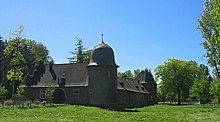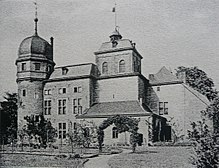Rimburg Castle
Castle Rimburg is in Wurmtal on the German-Dutch border near Ubach-Palenberg located moated castle . The village of Rimburg , a district of the municipality of Landgraaf , directly opposite the castle on the other side of the Wurm , belongs to the Netherlands, as the Wurm also represents the state border.
history
In the immediate vicinity of the palace complex, an army road, the Via Belgica , crossed the Wurm in Roman times . The passage across the river was secured by a Roman post station.
The first owner of Rimburg Castle was recorded in 1276 as a Herr von Mülrepas, Drost (burgrave) of the Duke of Limburg. In the feud between the duchies of Limburg and Brabant , the complex was partially destroyed by Duke John I of Brabant . The lords of Mülrepas also took the rebuilding of the castle , which probably took place around the turn of the 13th century, as an opportunity to further expand it to increase the defensive potential. The main castle was provided with four flanking towers and also received a strong outer fortification ring, which was occupied by four towers. The towers were equipped with shooting chambers and casemates , which were connected to the main castle by underground passages . The expansion measures resulted in an unusual defensive strength of the entire complex.
In 1323 the castle came to Gerard von Merode through marriage . The property remained in the possession of the von Merode family until the 15th century. The next owner was the von Gronsfeld family. In 1498 the Rimburg came to Johann I von Bronkhorst and was raised to free imperial rule .
In 1543, during the Jülich feud against the Duke of Jülich , Johann I von Bronckhorst was on the side of the German Emperor Karl V. Johann I, however, offered the castle to the Duke of Jülich as an open house . As a result, the castle could and was occupied by soldiers from the Duke of Jülich. Rimburg was then besieged by the imperial troops and partially destroyed.
In 1640 Jost Maximilian von Bronckhorst sold Rimburg to Baron Arnold von Boemer . During this time, Rimburg was frequently occupied by foreign troops, so it was conquered by French troops in 1673. The French intended to use the castle as a base after further expansion. Arnold von Boemer's widow, Catharina von Westerholt , asked the Governor of Maastricht to refrain from this plan and to withdraw the troops. This proposal seems to have been successful, as Spanish troops followed the French soldiers as early as 1678. In 1726 the Rimburg was owned by the Counts of Ligneville, the Count of Galen zu Ermelinghof and the Baron von Westerholt. In 1782 Christoph von Ligneville was its owner, who passed it on to Count Josef Goncry in 1792. At the beginning of the 19th century, Eduard Joppen von Beegden bought the castle and in 1879 a Mr. Weckbeker. Around 1900 it was owned by Johanna von Brauchitsch, born Weckbeker. In 1899, Johann von Brauchitsch had the property given a baroque facade based on a design by Professor Josef Kleesattel , the outer bailey was built and further alterations were made. During the Second World War , Rimburg Castle was integrated into the defensive positions on the western border and therefore fiercely fought over during the Allied advance into what is now federal territory in 1944.
In 1947, Dutch annexation plans were implemented as a result of World War II . After the Second World War, the Netherlands demanded compensation for the war damage. For this purpose, on April 23, 1949, in accordance with the final declaration of the London Germany Conference of December 23, 1948, various border areas were placed under Dutch contract administration. At Rimburg, the border should no longer represent the Wurm, but the railway line. Rimburg mill and castle and surrounding meadows became Dutch. In 1963, this area was also returned in the so-called Holland Treaty against payment of DM 280 million. The Wurm became Grenzbach again, but no longer in the old, meandering course, as the Wurm was straightened and expanded.
building
The moated castle is an extensive complex from the 12th to 14th and 19th centuries, consisting of the L-shaped outer bailey and the main castle itself . The outer and main castle are separated from each other by a wide moat. The main castle was originally surrounded by a curtain wall . The first plant from the 12th to the 13th century consisted of three wings, which together with the castle keep grouped around an inner courtyard. The medieval complex is still largely preserved, but changed in particular through renovations in the 19th century and considerable war damage. The outer ring of fortifications was reinforced by casemates in front of the walls. The surrounding buildings also included the Rimburg mills .
The privately owned castle is not open to the public.
literature
- Christian Quix : Castle and former lordship of Rimburg, the owners of the same, especially the counts and barons of Gronsfeld, along with the surrounding villages. Jacob Anton Mayer , Aachen 1835.
- Johann Heinrich Kaltenbach : The administrative district of Aachen, guide for teachers, travelers and friends of local history . Aachen 1850, pp. 386-388.
- H. Hanssen: The Rimburg. Aachen Publishing and Printing Company, Aachen 1912.
- Ernst von Oidtman : On the genealogy and heraldry of previous owners of the Rimburg. In: Zeitschrift des Aachener Geschichtsverein , No. 35, 1913, pp. 367–372.
- Wilhelm Piepers: Archeology in the Heinsberg district. Self-published by the Heinsberg district, 1989.
- Handbook of German Art Monuments , North Rhine-Westphalia I: Rhineland. Deutscher Kunstverlag, Munich 2005.
- Lutz H. Meyer in: Local calendar of the Heinsberg district 2011 . Self-published by the district of Heinsberg, Heinsberg 2011, p. 174 ff.
Web links
Individual evidence
Coordinates: 50 ° 54 ′ 50 ″ N , 6 ° 5 ′ 23 ″ E



